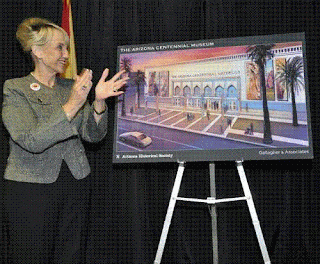During the Senate Hearing on House Bill 2251, many people appeared to speak in defense of the existing mineral museum. That did not stop the majority on the senate committee from voting for the bill as the Governor told them to, but one senator did offer an opportunity to amend the bill. The amendment was intended to preserve some worthy elements of the existing top rated mineral museum as the building is reassigned to the historical society for the centennial museum.
Mineral museum supporters and senate staff agreed on including the following provisions in the amendment:
1. The Arizona Mining and Mineral Museum would retain its name and identity, and would be housed within the centennial museum using a portion of the buildings floor space.
2. The curator would have appropriate scientific credentials (knowledge of or experience with minerals).
3. All existing mineral museum items and artifacts would be retained, including the outdoor displays.
4. The earth science educational programs that support state mandated K-12 science curriculum would continue.
Representatives of the Governors staff and the Arizona Historical Society (AHS) resisted these changes, but they did become part of the final bill as passed by House and Senate. The law became effective at the end of July, and the historical society has now taken control of the mineral museum building and mineral collection.
The initial AHS plan for the centennial museum was to inter-mingle the various items from the 5Cs. What ever remained of the mineral collection would not have been together in one place. The plan also included “relocation” of the outdoor displays. Will the historical society now comply with the law and revise the centennial museum plans to incorporate an intact mineral museum and retain the outdoor mining displays?
Notes:
The actual language (for respective provisions) in HB 2251 is as follows:
1. Page 5, line 19: The Arizona Historical Society shall operate and maintain the centennial museum that houses the mining and mineral museum …………….. Line 26: to maintain the mining and mineral museum as the state depository for collecting, cataloging, and displaying mining artifacts and specimens of various ores, gemstones, lapidary material and other valuable mineral specimens.
2. Page 6, line 1: To authorize the director to employ a curator for the museum. The curator shall possess knowledge or experience in mineral collecting or shall have other museum experience. (Note: somehow, during the legislative process. the word “and” became “or” in this statement thus destroying it’s obvious intent. As is now, a temporary janitor from the bead museum is qualified to be the curator).
3. Page 6, line 7: The Arizona Historical Society shall maintain the items, artifacts and other inventory received for display and storage, including equipment and out door displays, and shall not sell or otherwise dispose of materials received for the centennial museum or the mining and mineral museum.
4. Page 6, line 4: To operate educational programming for the museum.



